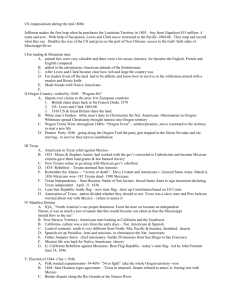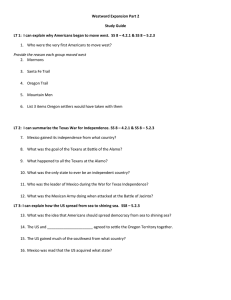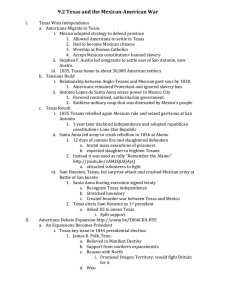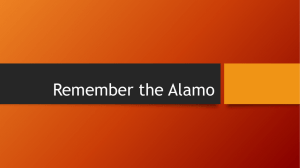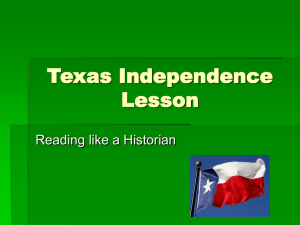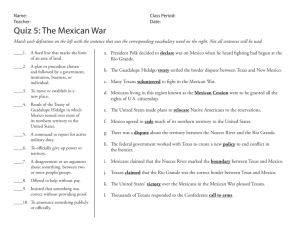Slide 1
advertisement
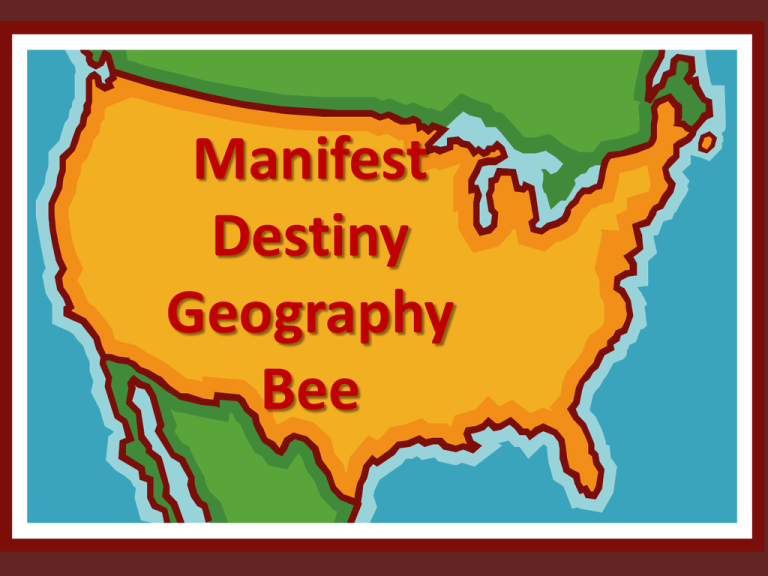
Manifest Destiny Geography Bee Q: What did Americans call their desire to spread out & claim land from the Atlantic to Pacific Ocean? A: Manifest Destiny Q: What New York newspaperman coined the term “Manifest Destiny”? A: John O’Sullivan Q: In one single person’s lifetime, the United States had grown how many times its original size? A: three times its original size Q: After exhausting the fur supply, mountain men found work as A: guides Q: What U.S. president agreed to annex Texas? A: Polk Q: The Mexican ranchos had which group of people working the land in exchange for food & shelter. A: Native Americans Q: Jim Bridger and Kit Carson lived in the West and worked as A: Guides Q: Which territory had a diverse population of Seminole Indians, Spanish colonists, & runaway slaves? A: Florida Q: What made slave owners in Georgia angry about the Florida territory? A: runaway slaves escaped there Q: What made plantation owners in Georgia angry about the Florida territory? A: Seminole Indians crossed into Georgia to attack their farms Q: What was America’s biggest complaint about how Spain governed Florida? A: Spain was so far away that their governing was weak Q: What military hero invaded Florida in 1818 to chase back the Seminoles? A: Andrew Jackson (Andrew Jackson also overthrew the Spanish government & took over the territory.) Q: What message did Secretary of State John Quincy Adams send to Spain regarding Florida? A: “Govern or Get Out” Q: What crop was the land in Texas best suited for? A: cotton Q: What did all settlers of Austin’s Texas have to agree to become? A: Mexican citizens & Catholics Q: What term describes Texans of Mexican descent? A: Tejanos Q: What did the country of Mexico outlaw in 1829 that bothered a lot of Americans moving into Texas? A: slavery Q: Who was the hotheaded young lawyer that called for a revolution against the Mexican government? A: William Travis Q: Who was the angry Mexican dictator/president/military leader that met with Stephen Austin to discuss the conflicts? A: General Antonio Lopez de Santa Anna Q: What was the name of the mission that Mexicans took control over in San Antonio? A: the Alamo Q: Who was the famous frontiersman & former congressman from Tennessee? A: Davy Crockett Q: Who was the well-known Texas “freedom fighter” for whom a knife is named? A: James Bowie Q: By what ratio were Texans outnumbered at the Battle of the Alamo? A: ten to one Q: What did Santa Anna order his troops to do to all of the survivors of the Battle of the Alamo? A: execute them Q: Who was the commander of the Texas revolutionary army? A: Sam Houston Q: At what river did Santa Anna catch up with Sam Houston? A: San Jacinto River Q: What did Houston shout repeatedly during the Battle of San Jacinto to help keep his troops focused? A: “Remember the Alamo!” Q: When Texans captured Santa Anna, what did they force him to sign? A: a treaty giving Texas their independence Q: What was the nickname for the state of Texas? A: the Lone Star Republic Q: What term means to add a territory to a country? A: annex Q: Under which President did Texas officially become one of the United States? A: President James K. Polk Q: (Delaware was the 1st state.) Which did Texas become? A: the 28th state Q: What did settlers call the enormous, tree-covered wilderness stretching from the Rockies to the Pacific to Alaska? A: Oregon Country Q: Oregon was claimed by four nations in 1819, including Russia and Spain. What were the other two countries? A: the U.S. & Britain Q: Whose expedition led to the United States’ interest in the Oregon Country? A: Lewis & Clark Q: Who was the young fur trapper that discovered a passage through the Rockies that was much more accessible for travelers? A: Jedediah Smith Q: What was the name of this passage? A: the South Pass Q: What types of settlers mainly traveled into the Oregon Country? A: missionaries Q: What term describes people who accept a new religion? A: converts Q: Who were these missionaries eager to convert to Christianity? A: Native Americans Q: What did most settlers to the Oregon Country travel in? A: prarie schooners Q: What campaign slogan for James K. Polk described the fight over the latitude of the U.S.’s claims to the Oregon Country? A: “fifty four forty or fight!” Q: At what line of latitude did the United States & Great Britain agree to divide the Oregon Country? A: 49th parallel Q: How did Mexico respond when Polk offered to buy the territories of California & New Mexico? A: the refused to see him Q: What river did Texans claim was their border between the United States & Mexico? A: the Rio Grande River Q: What river did Mexicans claim was their border between Texas & Mexico? A: the Nueces River Q: When Mexican soldiers fired shots on Texans near the Rio Grande River, what did Congress do? A: declare war on Mexico Q: Under the direction of General Stephen Kearny, what did the United States Army do in New Mexico? A: they occupied it (took control) Q: When troops took over Northern California, what emblem did they draw on their flag? A: a bear Q: Who was the “rough & ready” no-nonsense general who fought Santa Anna near the Buena Vista ranch? A: Zachary Taylor Q: At what castle did Americans & Mexicans continue their battle? A: Chapultepec Q: What do Mexicans call the six heroic cadets who chose to die fighting rather than to surrender? A: Los Ninos Heroes (the heroic children) Q: At what capital city did Mexico finally surrender to the United States? A: Mexico City Q: What treaty did Mexico & the United States agree to in 1848? A: the Treaty of Guadalupe Hidalgo Q: In this treaty, what did Mexico agree to give up? A: half of their territory Q: What term means to “give up” something? A: cede or cession Q: What did the United States agree to give Mexico in return? A: $15 million Q: Under the terms of the treaty, who did the United States agree to protect? A: Treaty of Guadalupe Hildago Q: What term describes a grant of land made by the Mexican government, used to raise cattle & crops? A: rancho Q: What term described the typical Spanish-speaking Californian? A: Californio Q: What became California’s most important industry in the 1830s? A: cattle ranching Q: What did a number of Mountain Men leave behind as their legacy? A: their personal journals Q: What were the names of one of the couples who first traveled the Oregon Trail? A: Marcus & Narcissa Whitman or Henry & Eliza Spalding Q: Why were these couples traveling to the Oregon Country? A: they aimed to convert Native Americans to Christianity Q: What Native American tribe were the Whitmans not able to convert & actually deeply offended? A: the Cayuse Indians Q: What Native American tribe did the Spaldings succeed in converting to Christianity? A: the Nez Perce Indians Q: What term describes a plot of land where pioneers could build a home, farm, or ranch? A: homestead Q: In what town did many of the pioneer women meet to begin their journey west? A: Independence, Missouri Q: Approximately how long was the journey west that covered 2,000 miles? A: four to six months Q: What was the worst killer for pioneers heading west? A: disease Q: What religion is also referred to as the Church of Jesus Christ of Latter-Day (Modern) Saints? A: Mormons Q: Who was the leader of the Mormon church who persuaded others to join him in Utah? A: Brigham Young Q: Next to what body of water in Utah did the Mormons settle? A: Great Salt Lake Q: What Mormon practice did many people find to be most offensive? A: polygamy (having more than one wife) Q: Who did an angry mob (resenting the Mormon’s power and wealth) kill in 1844? A: Joseph Smith Q: What was the main reason Mormons chose to settle in the west? A: freedom from religious persecution Q: Who was the first man to spot gold in a river in Northern California? A: James Marshall Q: What term describes the people (almost all young men) who joined the rush for gold in California in 1849? A: forty-niners Q: What was extremely scarce about life in California during the gold rush? A: women Q: What made the gold camps rough places? A: no police Q: What was the greatest legacy left by the gold miners? A: California’s population grew large enough to become the first western state Q: What did the Chinese call the “Gold Mountain” in California in 1848? A: Gam Saan Q: By 1852, what percentage of California’s population were Chinese? A: 10% Q: What law did California’s state legislature pass in 1852 that discriminated against the Chinese? A: required foreign miners to pay a monthly fee for a license to mine Q: What Californian town did many Chinese immigrants settle into, which is today still the largest Chinese population in the United States? A: San Francisco

